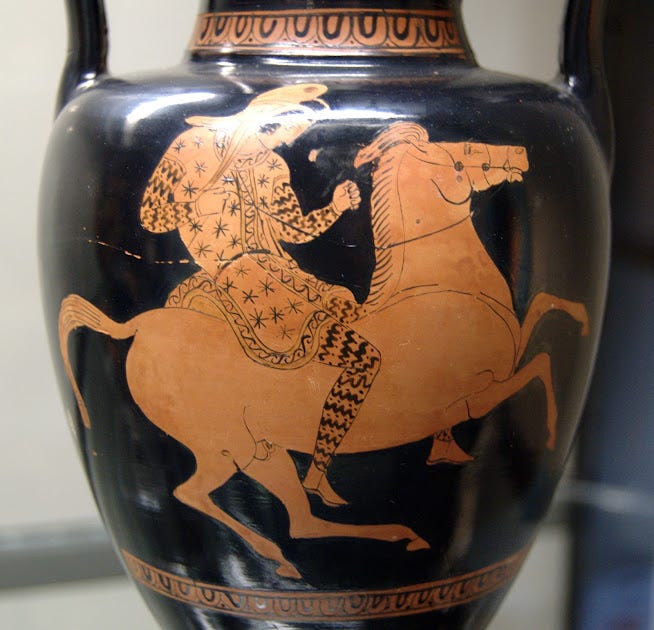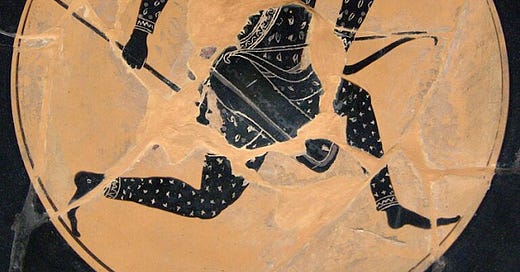Scythian mercenaries employed in the ancient Greek Colony of Himera
A very interesting article came out a few days ago, providing us insight into the ancient native inhabitants of Siciliy and the dynamics of the Greek colony of himera. We also got a glimpse into the soldiers employed in this colony, and we really got some fascinating results.
The diverse genetic origins of a Classical period Greek army
Laurie J. Reitsema https://orcid.org/0000-0003-1127-3496 reitsema@uga.edu, Alissa Mittnik https://orcid.org/0000-0002-6963-4824 alissa_mittnik@hms.harvard.edu, Britney Kyle britney.kyle@unco.edu, +46 , Giulio Catalano https://orcid.org/0000-0002-2564-5775, Pier Francesco Fabbri https://orcid.org/0000-0003-3633-0178, Adam C. S. Kazmi, Katherine L. Reinberger https://orcid.org/0000-0001-9978-8421, Luca Sineo https://orcid.org/0000-0001-8634-2295, Stefano Vassallo, Rebecca Bernardos https://orcid.org/0000-0003-4625-3727, Nasreen Broomandkhoshbacht https://orcid.org/0000-0001-5350-1608, Kim Callan, Francesca Candilio https://orcid.org/0000-0002-4668-1361, Olivia Cheronet https://orcid.org/0000-0001-6760-1204, Elizabeth Curtis, Daniel Fernandes https://orcid.org/0000-0002-7434-6552, Martina Lari https://orcid.org/0000-0002-7832-8212, Ann Marie Lawson https://orcid.org/0000-0003-0990-2329, Matthew Mah, Swapan Mallick, Kirsten Mandl https://orcid.org/0000-0002-2078-0775, Adam Micco, Alessandra Modi, Jonas Oppenheimer, Kadir Toykan Özdogan, Nadin Rohland, Kristin Stewardson, Stefania Vai https://orcid.org/0000-0003-3844-5147, Chiara Vergata https://orcid.org/0000-0003-2727-7977, J. Noah Workman https://orcid.org/0000-0002-0921-1803, Fatma Zalzala https://orcid.org/0000-0002-8981-1277, Valentina Zaro https://orcid.org/0000-0002-2902-225X, Alessandro Achilli https://orcid.org/0000-0001-6871-3451, Achilles Anagnostopoulos https://orcid.org/0000-0003-4384-9031, Cristian Capelli, Varnavas Constantinou https://orcid.org/0000-0002-5479-5529, Hovirag Lancioni https://orcid.org/0000-0001-5514-1853, Anna Olivieri, Anastasia Papadopoulou https://orcid.org/0000-0001-5385-8738, Nikoleta Psatha, Ornella Semino https://orcid.org/0000-0002-9675-9403, John Stamatoyannopoulos, Ioanna Valliannou, Evangelia Yannaki, Iosif Lazaridis https://orcid.org/0000-0002-4094-9347, Nick Patterson, Harald Ringbauer, David Caramelli https://orcid.org/0000-0001-6468-1675 david.caramelli@unifi.it, Ron Pinhasi https://orcid.org/0000-0003-1629-8131 ron.pinhasi@univie.ac.at, and David Reich https://orcid.org/0000-0002-7037-5292 reich@genetics.med.harvard.edu-46Authors Info & Affiliations
October 3, 2022 119 (41) e2205272119 https://doi.org/10.1073/pnas.2205272119
Abstract
Trade and colonization caused an unprecedented increase in Mediterranean human mobility in the first millennium BCE. Often seen as a dividing force, warfare is in fact another catalyst of culture contact. We provide insight into the demographic dynamics of ancient warfare by reporting genome-wide data from fifth-century soldiers who fought for the army of the Greek Sicilian colony of Himera, along with representatives of the civilian population, nearby indigenous settlements, and 96 present-day individuals from Italy and Greece. Unlike the rest of the sample, many soldiers had ancestral origins in northern Europe, the Steppe, and the Caucasus. Integrating genetic, archaeological, isotopic, and historical data, these results illustrate the significant role mercenaries played in ancient Greek armies and highlight how participation in war contributed to continental-scale human mobility in the Classical world.
Amazing right? Especially the findings of the Northeast European warriors amongst the mercenaries was a surprise and very interesting to me. Also the fact that the conflict these foreign soldiers were involved in was attested but their presence wasn't. Given the namesake of the blog however I will focus on the soldiers that came from the steppes. The two samples at hand are I10944/W0461 and I10947/W1774, together forming the cluster of Sicily_Himera_480BCE_4.

Context
Both of the samples were young adult males that were found in the 480 BC battle context, and thus they likely perished in combat.
he two samples came from these two mass burials. Unfortunately due to the image quality I really can’t make out which skeletons are supposed to correspond with the genomes, but I guess I can take solace in knowing it is one of the yellow ones?
I10944 is one of the yellow skeletons displayed in the image of the mass gravess 1/2 below:

Whereas I10947 was part of mass grave #3, also displayed below:

I really wish they provided us better materials when it came to the graves.
The authors also provided some insights using isotopes. The isotopic data provided cannot give us an estimation as to where these samples came from, although it can be ruled out they grew up in Himera.
We correlated the diversity in genetic histories with strontium and oxygen isotope data gathered from the teeth of Himeran individuals in previous research (37). For all the individuals from the civilian sample, all the individuals from 409 BCE graves, and most of the individuals in the 480 BCE graves determined to be Aegean related (five of seven), the strontium isotopic ratios are consistent with local origins (37). In contrast, all 480 BCE soldiers with primary genetic affinities with central Europe, northeastern Europe, the Eurasian steppe, and Armenia are isotopically nonlocal (Fig. 3). The low oxygen ratios of some individuals are characteristic of higher latitudes, higher altitudes, cooler climates, greater rainfall, and greater distances from coasts than Himera, and the high strontium isotope ratios of some individuals indicate more ancient underlying rocks and soils than at Himera (37, 74). The outlying isotopic data by themselves do not prove non-Sicilian origins for the individuals from Himera: similar outlying ratios for both isotopes can also be found in other parts of Sicily, albeit not in the immediate region of Himera. However, the agreement between genetic and isotopic evidence, showing that all nine individuals with outlying genetic profiles also have nonlocal isotopic profiles, provide compelling evidence that many soldiers who fought in the battle of 480 BCE came from distant regions of the known Greek world.
The period of these two samples would have been around the time that Scythians were present in Athens, mainly as the “Scythian Archers”, hypothesized to be a police force and attested through Aristophanes’ works as well as vase paintings from Athens. They would also be contemporary to Herodotus, although being born in 484 BC he would have been a young boy when these soldiers met their fate. Thus finding Scythians employed by Greeks in such a context should not be too surprising, but that does not make it any less cool.

Genetics
As far as uniparental markers go, I10944 had Y-dna R-Z2124*, which is a subclade of R1a-Z93. His mtdna haplogroup was A6a. I10947 on the other hand has Y-DNA N*, which is unfortunately a bit undetermined. Hopefully we can get some further resolution down the line. His maternal haplogroup was N1a1a1a.
If you are familiar with the origins of Scythian populations then these uniparental markers should not be surprising. If they are surprising to you, you should read more of my content :)
The authors made a great Principal Component Analysis (PCA) chart that shows the position of the samples.

The segment on them in the article was rather short, this more or less being it:
Two (I10944/W0461 and I10947/W1774; Sicily_Himera_480BCE_4) fall with individuals from IA nomadic contexts in the Eurasian Steppe and carry in the ADMIXTURE analysis genetic components maximized in Han and Karitiana (Native Americans) that characterize most IA Steppe nomads (light green and purple, respectively, in SI Appendix, Fig. S2B). In qpAdm, their ancestry is consistent, with around 85–89% deriving from IA Central steppe nomads and 11–15% from an Aegean-like source, an admixture that plausibly could have taken place among the genetically diverse populations of the Steppe (68, 69). Their mitochondrial DNA (mtDNA) haplogroups suggest east Eurasian genetic roots: A6a, found so far only in modern-day China (70, 71), and N1a1a1a, restricted to Russia, Kazakhstan, and Mongolia (72).
Fortunately there was more information regarding genetics in the supplementary file:
This group yields no feasible models when using only the common 4 distal sources for European populations. Due to the position on the PCA clustering with IA steppe nomads and the additional ancestry component maximized in East Asians (Fig. 2B), we moved Russia_Shamanka_Eneolithic.SG to the sources, accounting for any East Asian-related ancestry also seen in varying proportions in contemporaneous Steppe nomads (46, 47), resulting in models that are not rejected. The individuals can be modeled as 20-28% Turkey_N_Barcin, 59-63% Russia_Samara_EBA_Yamnaya and 12-16% Russia_Shamanka_Eneolithic.SG (Dataset S5). As a group, the best-fitting model (p=6.19E-01; Table S8) is Turkey_N_Barcin (21.2 ± 2.4%), Russia_Samara_EBA_Yamnaya (62.4 ± 3.2%), Russia_Shamanka_Eneolithic.SG (10.2 ± 2.4%) and CHG (6.2 ± 3.6%).
Using more proximal sources of ancestry, we tested 1-, 2-, and 3-way models of, CentralSteppe_IA_Nomadic_EA1, CentralSteppe_IA_Nomadic_EA2, CentralSteppe_IA_Nomadic_o, CentralSteppe_IA_Nomadic_Steppe, WesternSteppe_IA_Nomadic_EA, WesternSteppe_IA_Nomadic_intermediate, WesternSteppe_IA_Nomadic_NE, WesternSteppe_IA_Nomadic_o, WesternSteppe_IA_Nomadic_Steppe, TianShan_IA_Nomadic, TianShan_IA_Nomadic_o1, TianShan_IA_Nomadic_o2, TianShan_IA_Nomadic_o3, SouthernSiberia_IA_Nomadic, WesternSteppe_IA_Nomadic_SE, Hungary_IA_Prescythian.SG and Hungary_IA_Scythian.SG (Table S12). We find a working 1-way model in TianShan_IA_Nomadic_o2 (p=1.53E-01; Table S12), a genetic outlier who appears to carry more Western Eurasian ancestry than the main cluster of contemporaneous nomads sampled from the TianShan region. Since this group is only represented by a single individual, we also report working 2-way models, which include the Mediterranean sources or groups known to have more western Eurasian affinity. We investigate the possible source of western Eurasian admixture further by running the competitive modeling approach. While none of the models return a p-value>0.01, the 2-way models with the highest pvalue (p>3.86E-04), derive ~88% of ancestry from CentralSteppe_IA_Nomadic_Steppe (i.e. individuals associated with nomadic IA cultures excavated in the Central region of the Eurasian steppes, who genetically resemble BA Steppe pastoralists with added East Asian/Siberian gene flow), and ~12% from an Aegean source (represented by Greece_LBA or Sicily_Himera_480BCE_1), consistent with two 3-way models with the highest p-values (1.19E-03 and 1.27E-03, respectively) that require, in addition to ~79% CentralSteppe_IA_Nomadic_Steppe and ~13-15% of an Aegean source, around 6-7% ancestry deriving from CentralSteppe_IA_Nomadic_EA1 (Table S12). The rejection of these models suggests that while a western Eurasian, and possibly Mediterranean source is plausible, we have not used the exact contributing source in our models. This admixture between groups from the steppe and western Eurasia could have taken place in the steppe, since IA Steppe nomads such as the Scythians were genetically very homogeneous and also included individuals of mostly Aegean ancestry (47, 48); furthermore, Aegean migrants living in Greek colonies on the shores of the Black Sea are likely to have been in contact with the neighboring nomadic populations.
I think that the steppe ancestry is overblown here due to the model not properly accounting for central asian and west-siberian ancestry.
In addition to these two Scythian samples we also have the Caucasian sample. It has the y-chromosme haplogroup R-FGC4547, which is a subclade of R1a-z93. If the sample got his y-dna from iron age nomads it must’ve happened centuries prior, leaving little autosomal ancestry as the sample is modeled like this:
Sicily_Himera_480BCE_5 This individual could be modeled as a 4-way model (p=1.73E-2; Dataset S5), as a 4-way model of Turkey_N_Barcin (33.4 ± 3.7%), WHG (1.3 ± 3.5%), Russia_Samara_EBA_Yamnaya (20.1 ± 6.4%) and CHG (45.2 ± 5.8%). This is consistent with no WHG contribution; however, the corresponding 3-way model is rejected (p=4.02E-3). Using more proximal sources of ancestry, we tested 1-, 2-, and 3-way models of Sicily_IA, Greece_Crete_BA, Greece_LBA, Turkmenistan_IA.SG, Armenia_EBA, Armenia_MBA.SG, Armenia_MBA, Armenia_LBA.SG, Iran_Hasanlu_IA.SG, CentralSteppe_IA_Nomadic_Steppe, TianShan_IA_Nomadic, TianShan_IA_Nomadic_o3, CentralSteppe_IA_Nomadic_o, Turkey_IA_o3.SG, WesternSteppe_IA_Nomadic_intermediate, Tajikistan_Ksirov_Kushan and Iran_IA_HajjiFiruz. A single 1-way model with Armenia_MBA as the source was valid (p=0.293).
So without a contribution from East Asian populations. It is also possible this lineage came by way of bronze age Srubnaya populations. R-FGC4547 is the upstream clade of R-Y52, a clade also seen in several Sarmatian samples.
That is pretty much it? Probably the shortest blog entry I have done in a while. But don't fret my dear friends because I will be dropping some good content in the near future. After all, my one year anniversary is looming :) In the meantime, I hope we can get our hands on these samples early.

Another vase painting containing a Scythian archer, made by the famed Epiktetos



